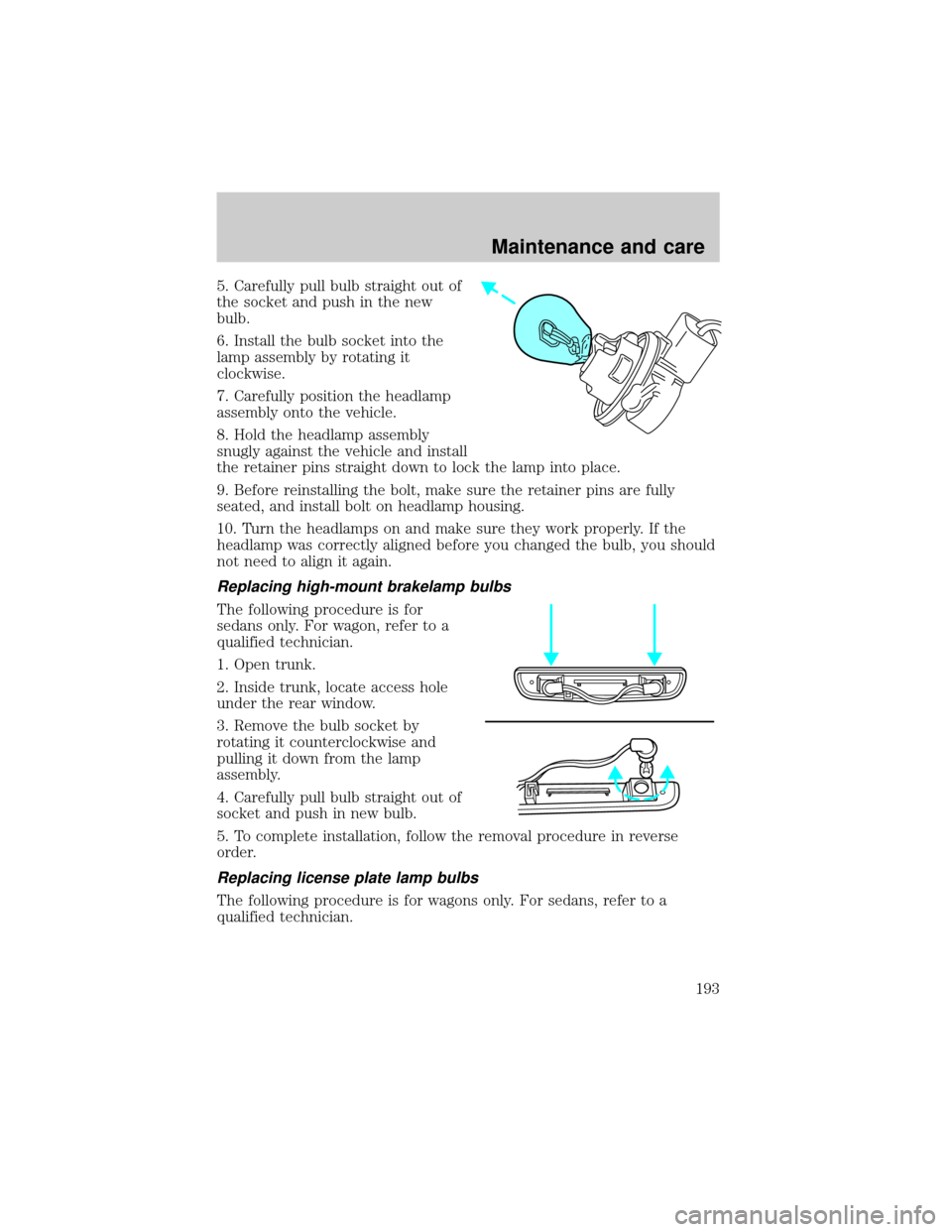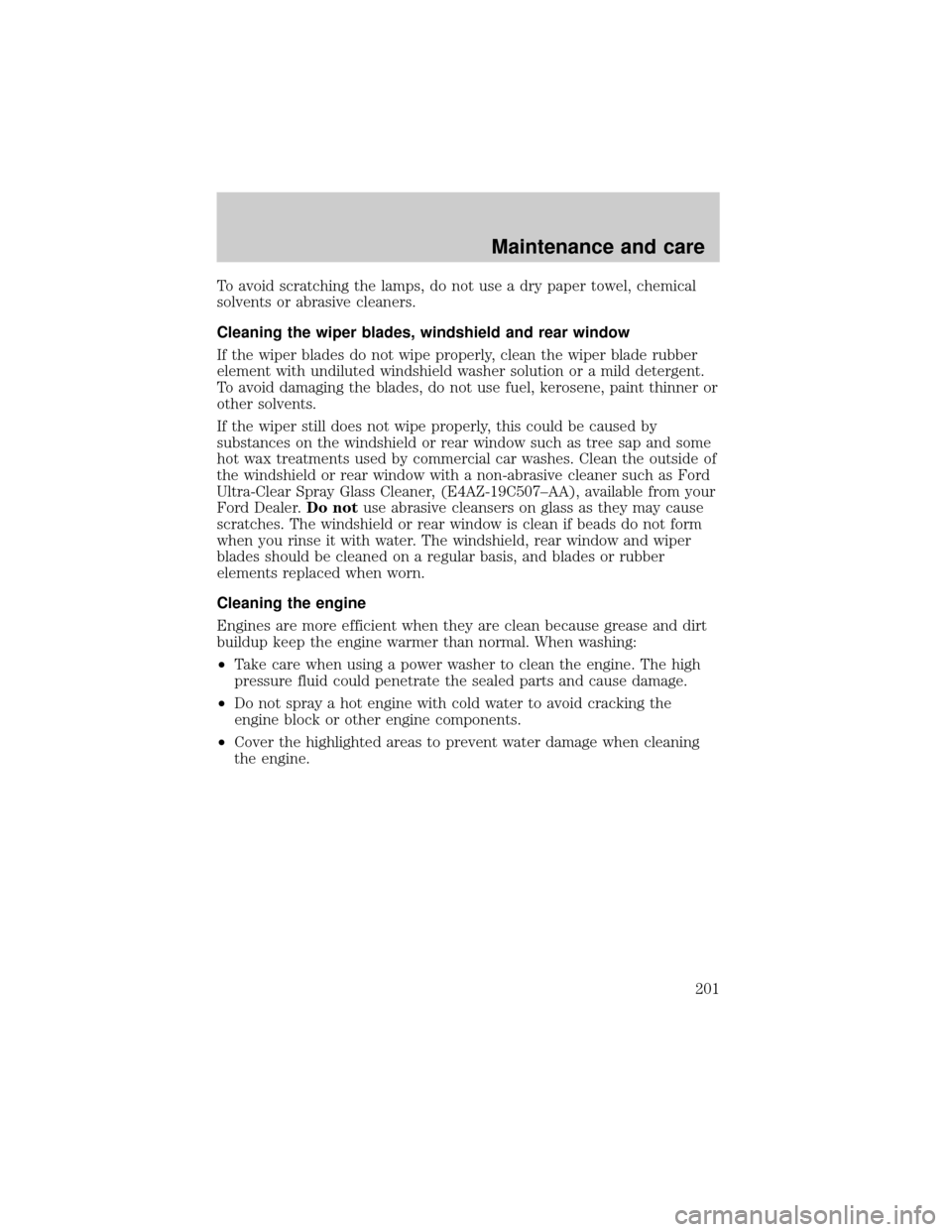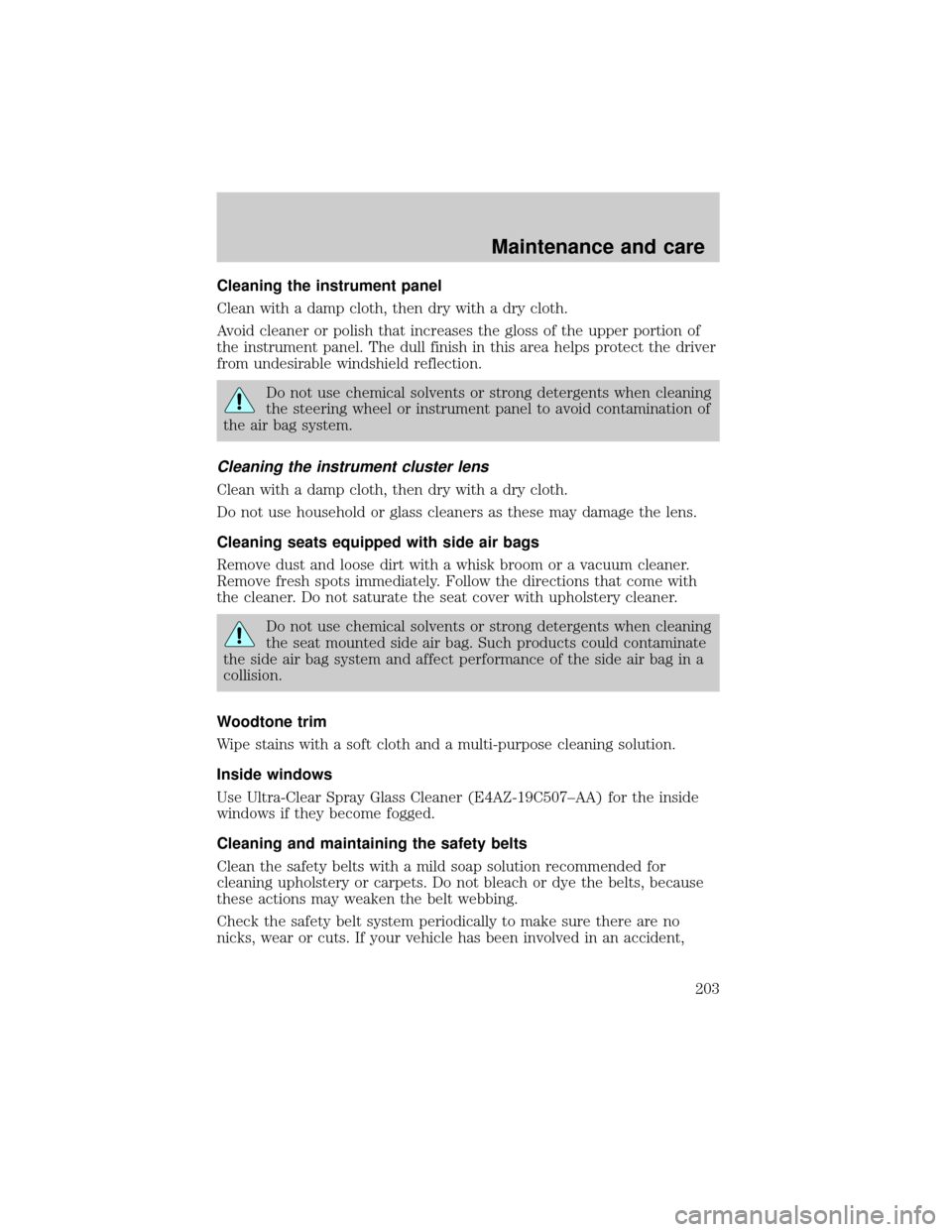2000 FORD TAURUS window
[x] Cancel search: windowPage 174 of 232

Changing the wiper blades
To replace the wiper blades:
1. Pull the wiper arm away from the
windshield and lock into the service
position.
2. Turn the blade at an angle from
the wiper arm. Push the lock pin
manually to release the blade and
pull the wiper blade down toward
the windshield to remove it from the
arm.
3. Attach the new wiper to the
wiper arm and press it into place
until a click is heard.
REAR WINDOW WIPER BLADES
Refer toWindshield Wiper Bladesin this section for more information
on rear wiper blades.
INFORMATION ABOUT UNIFORM TIRE QUALITY GRADING
New vehicles are fitted with tires
that have a rating on them called
Tire Quality Grades. The Quality
grades can be found where
applicable on the tire sidewall
between tread shoulder and
maximum section width. For
example:
²Treadwear 200 Traction AA Temperature A
These Tire Quality Grades are determined by standards that the United
States Department of Transportation has set.
Tire Quality Grades apply to new pneumatic tires for use on passenger
cars. They do not apply to deep tread, winter-type snow tires,
space-saver or temporary use spare tires, tires with nominal rim
diameters of 10 to 12 inches or limited production tires as defined in
Title 49 Code of Federal Regulations Part 575.104(c)(2).
Maintenance and care
174
Page 187 of 232

²Resting your foot on the brake pedal while driving may reduce fuel
economy.
²Combine errands and minimize stop-and-go driving.
Maintenance
²Keep tires properly inflated and use only recommended size.
²Operating a vehicle with the wheels out of alignment will reduce fuel
economy.
²Use recommended engine oil. Refer toLubricant Specifications.
²Perform all regularly scheduled maintenance items. Follow the
recommended maintenance schedule and owner maintenance checks
found in your vehicle Scheduled Maintenance Guide.
Conditions
²Heavily loading a vehicle or towing a trailer may reduce fuel economy
at any speed.
²Carrying unnecessary weight may reduce fuel economy (approximately
0.4 km/L [1 mpg] is lost for every 180 kg [400 lb] of weight carried).
²Adding certain accessories to your vehicle (for example bug
deflectors, rollbars/light bars, running boards, ski/luggage racks) may
reduce fuel economy.
²Using fuel blended with alcohol may lower fuel economy.
²Fuel economy may decrease with lower temperatures during the first
12±16 km (8±10 miles) of driving.
²Driving on flat terrain offers improved fuel economy as compared to
driving on hilly terrain.
²Transmissions give their best fuel economy when operated in the top
cruise gear and with steady pressure on the gas pedal.
²Close windows for high speed driving.
EPA window sticker
Every new vehicle should have the EPA window sticker. Contact your
dealer if the window sticker is not supplied with your vehicle. The EPA
window sticker should be your guide for the fuel economy comparisons
with other vehicles.
It is important to note the box in the lower left corner of the window
sticker. These numbers represent the Range of L/100 km (MPG)
Maintenance and care
187
Page 193 of 232

5. Carefully pull bulb straight out of
the socket and push in the new
bulb.
6. Install the bulb socket into the
lamp assembly by rotating it
clockwise.
7. Carefully position the headlamp
assembly onto the vehicle.
8. Hold the headlamp assembly
snugly against the vehicle and install
the retainer pins straight down to lock the lamp into place.
9. Before reinstalling the bolt, make sure the retainer pins are fully
seated, and install bolt on headlamp housing.
10. Turn the headlamps on and make sure they work properly. If the
headlamp was correctly aligned before you changed the bulb, you should
not need to align it again.
Replacing high-mount brakelamp bulbs
The following procedure is for
sedans only. For wagon, refer to a
qualified technician.
1. Open trunk.
2. Inside trunk, locate access hole
under the rear window.
3. Remove the bulb socket by
rotating it counterclockwise and
pulling it down from the lamp
assembly.
4. Carefully pull bulb straight out of
socket and push in new bulb.
5. To complete installation, follow the removal procedure in reverse
order.
Replacing license plate lamp bulbs
The following procedure is for wagons only. For sedans, refer to a
qualified technician.
Maintenance and care
193
Page 201 of 232

To avoid scratching the lamps, do not use a dry paper towel, chemical
solvents or abrasive cleaners.
Cleaning the wiper blades, windshield and rear window
If the wiper blades do not wipe properly, clean the wiper blade rubber
element with undiluted windshield washer solution or a mild detergent.
To avoid damaging the blades, do not use fuel, kerosene, paint thinner or
other solvents.
If the wiper still does not wipe properly, this could be caused by
substances on the windshield or rear window such as tree sap and some
hot wax treatments used by commercial car washes. Clean the outside of
the windshield or rear window with a non-abrasive cleaner such as Ford
Ultra-Clear Spray Glass Cleaner, (E4AZ-19C507±AA), available from your
Ford Dealer.Do notuse abrasive cleansers on glass as they may cause
scratches. The windshield or rear window is clean if beads do not form
when you rinse it with water. The windshield, rear window and wiper
blades should be cleaned on a regular basis, and blades or rubber
elements replaced when worn.
Cleaning the engine
Engines are more efficient when they are clean because grease and dirt
buildup keep the engine warmer than normal. When washing:
²Take care when using a power washer to clean the engine. The high
pressure fluid could penetrate the sealed parts and cause damage.
²Do not spray a hot engine with cold water to avoid cracking the
engine block or other engine components.
²Cover the highlighted areas to prevent water damage when cleaning
the engine.
Maintenance and care
201
Page 203 of 232

Cleaning the instrument panel
Clean with a damp cloth, then dry with a dry cloth.
Avoid cleaner or polish that increases the gloss of the upper portion of
the instrument panel. The dull finish in this area helps protect the driver
from undesirable windshield reflection.
Do not use chemical solvents or strong detergents when cleaning
the steering wheel or instrument panel to avoid contamination of
the air bag system.
Cleaning the instrument cluster lens
Clean with a damp cloth, then dry with a dry cloth.
Do not use household or glass cleaners as these may damage the lens.
Cleaning seats equipped with side air bags
Remove dust and loose dirt with a whisk broom or a vacuum cleaner.
Remove fresh spots immediately. Follow the directions that come with
the cleaner. Do not saturate the seat cover with upholstery cleaner.
Do not use chemical solvents or strong detergents when cleaning
the seat mounted side air bag. Such products could contaminate
the side air bag system and affect performance of the side air bag in a
collision.
Woodtone trim
Wipe stains with a soft cloth and a multi-purpose cleaning solution.
Inside windows
Use Ultra-Clear Spray Glass Cleaner (E4AZ-19C507±AA) for the inside
windows if they become fogged.
Cleaning and maintaining the safety belts
Clean the safety belts with a mild soap solution recommended for
cleaning upholstery or carpets. Do not bleach or dye the belts, because
these actions may weaken the belt webbing.
Check the safety belt system periodically to make sure there are no
nicks, wear or cuts. If your vehicle has been involved in an accident,
Maintenance and care
203
Page 226 of 232

windows ..................................203
wiper blades ............................201
woodtone trim ........................203
Climate control (see Air
conditioning or Heating) ............18
Clock .......................................31,38
Console ........................................56
Controls
power seat .................................75
Coolant
checking and adding ..............157
refill capacities .................161,206
specifications ...................207,208
Cruise control
(see Speed control) ....................44
Customer Assistance ................130
Ford accessories
for your vehicle ......................219
Ford Extended
Service Plan ............................212
Getting assistance outside
the U.S. and Canada ..............218
Getting roadside assistance ...130
Getting the
service you need ....................212
Ordering additional
owner's literature ...................223
The Dispute
Settlement Board ...................215
Utilizing the Mediation/
Arbitration Program ...............218
Daytime running lamps
(see Lamps) ................................16
Defrost
rear window ..............................17
Dipstick
automatic
transmission fluid ...................163
engine oil .................................152
Doors
door ajar warning .......................9
lubricant specifications ..........207Driving under special
conditions
through water .........................124
Emergencies, roadside
jump-starting ..........................142
Emission control system ..........188
Engine ........................................208
check engine/
service engine soon light ...........9
cleaning ...................................201
coolant .....................................157
idle speed control ...................171
lubrication
specifications ...................207,208
refill capacities ........................206
service points ...................150,151
starting after a collision .........131
Engine block heater .................111
Engine oil ..................................152
checking and adding ..............152
dipstick ....................................152
filter, specifications .........154,205
recommendations ...................154
refill capacities ........................206
specifications ...................207,208
Exhaust fumes ..........................112
Floor mats ...................................56
Fluid capacities .........................206
Fuel ............................................178
calculating fuel economy .......184
cap ...........................................181
capacity ...................................206
choosing the right fuel ...........182
comparisons with EPA fuel
economy estimates .................187
detergent in fuel .....................184
filling your vehicle
with fuel ....................178,181,185
filter, specifications .........184,205
fuel pump shut-off switch .....131
gauge .........................................15
improving fuel economy ........184
Index
226
Page 229 of 232

Speed control ..............................44
Speedometer ...............................13
Starting your vehicle .........108,110
jump starting ..........................142
Steering wheel
tilting .........................................49
Tachometer .................................14
Tires ......................138,174,175,176
changing ...........................138,139
checking the pressure ............176
replacing ..................................177
rotating ....................................176
snow tires and chains ............177
tire grades ...............................175
treadwear ................................175
Towing ................................125,176
recreational towing .................128
trailer towing ..........................125
wrecker ....................................147
Traction control ...................43,116
active light ..................................8
Transaxle
automatic operation ...............118
fluid, refill capacities ..............206
lubricant specifications ..........208
Transmission
fluid, checking and adding
(automatic) .............................163lubricant specifications ..........207
Trip odometer .............................15
Trunk ............................58,60,61,72
remote release ..........................57
Turn signal ...............................8,47
Vehicle dimensions ...................208
Vehicle Identification Number
(VIN) ..........................................211
Vehicle loading ..........................123
Ventilating your vehicle ...........112
Warning chimes ...........................13
Warning lights (see Lights) .........8
Washer fluid ..............................156
Water, Driving through .............124
Windows
power .........................................53
rear wiper/washer .....................48
Windshield washer fluid and
wipers
checking and adding fluid .....156
checking and cleaning .....173,174
liftgate reservoir .....................157
operation ...................................47
replacing wiper blades ...........174
Wrecker towing .........................147
Index
229